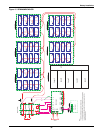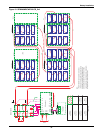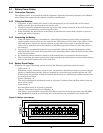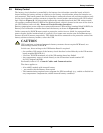
Battery Installation
38
2.4 Battery Power Cables
2.4.1 Connection Principles
The following notes, in conjunction with the diagrams, illustrate the broad principles to be followed
when fitting and connecting the majority of battery installations.
2.4.2 Fitting the Batteries
1. In general, at least 10mm (3/8") must be left unobstructed on all vertical sides of the battery
blocks to permit free air movement around the cells.
2. Clearance should be allowed between the top of the cells and the underside of the shelf above (this
is necessary for monitoring and servicing the cells).
3. When installing the batteries on racks always work from the bottom shelf upwards to prevent
raising the centre of gravity.
2.4.3 Connecting the Battery
1. When the battery cabinet is installed on a raised floor the battery power cables and optional
circuit breaker control cables can be routed to the UPS cabinet via the floor of the cabinet. If the
UPS and battery cabinet are located adjacent to each other and located on a solid floor these
cables can be passed between the cabinets via the lifting apertures located in the lower sides of
the cabinets.
2. In general it is recommended that the inter-connecting cables be fitted to the batteries within
their particular level before fitting the inter-level connecting cables, followed finally by the cables
to the circuit breaker.
3. An insulating shroud should be fitted to each terminal after its connection has been made.
4. When connecting the cables between the battery string ends to the optional circuit breaker always
connect the circuit breaker end of the cable first.
2.4.4 Battery Room Design
Whatever the type of mounting system selected, the following conditions should be noted:
• Cell Layout—1
Whichever battery mounting system is used, the batteries should be arranged to prevent the pos-
sibility of simultaneous contact with two exposed live parts having a potential greater an 150V.
Where this is not possible, insulated terminal shields must be installed and insulated cables must
be used for connections.
• Service Platform—2
The service platform (or duckboard) must be slip-proof, insulated from the floor and at least one
metre (39 in.) wide.
• Connections—3
All connections must be as short as possible.
• Battery Protection Fuses/Circuit Breaker—4
The battery circuit breaker is generally installed at the front of the battery room. See 2.5 - Bat-
tery Control for details on connecting the circuit breaker box available for the Liebert NX.
Figure 23 Battery room design
1
2
3
4


















